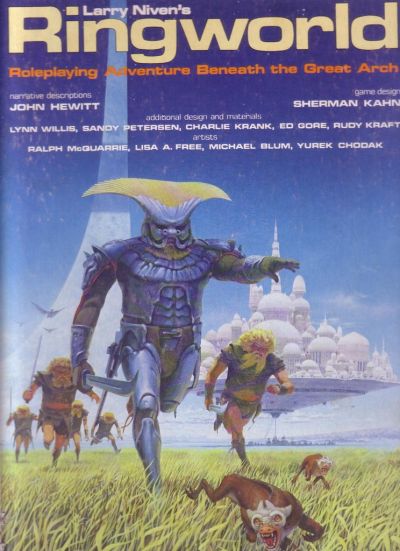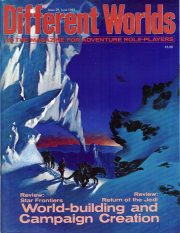A Labour of Love
Larry Niven’s Ringworld: Roleplaying Adventure Beneath the Great Arch
By John Hewitt & Sherman Kahn

21 Jul, 2015
0 comments
Many, many role-playing game companies have been tempted into doing RPG adaptations of established media franchises, such as books, TV shows, or movies. The attraction is obvious; the product comes with a built-in market. Unfortunately, there are also many, many pitfalls. Many of the companies who have dabbled in licensed products have emerged from the experience poorer for it. There’s a trick to surviving adaptations and not every company has it.

Way back in 1983, I was thrilled to read in Different Worlds 29 that Chaosium Games had acquired the rights to do a role-playing game based on Larry Niven’s Ringworld (a title that did not at that time inspire feelings of melancholy and despair over the decline of a once-great author). Not only had Chaosium created Runequest, one of my favourite RPGs, but they had ample experience at turning literary properties into games1. By 1983, Chaosium’s licensed products included Thieves’ World, Stormbringer, and of course Call of Cthulhu.
It’s not entirely true to say that Ringworld the RPG got caught up in Development Hell, but I do think it’s safe to say the project turned out to be bigger than John Hewitt or any of the other people involved could have envisioned. Despite delays, Larry Niven’s Ringworld: Roleplaying Adventure Beneath the Great Arch was finally released in 19842.
And what did a youthful James find when he popped open his copy of the game?
The first things I noticed were the production values: exceptionally high for a game of this era. As was Chaosium’s custom for licensed games at this time, Larry Niven’s Ringworld came in a box3. The cover featured Ralph McQuarrie art; you may be more familiar with McQuarrie for his work on Star Wars. Also listed was an impressive list of creative talent. In addition to author John Hewitt and game designer Sherman Kahn, the design staff included Lynn Willis, Sandy Petersen, Charlie Krank, Ed Gore, and Rudy Kraft, while artists included not just McQuarrie but also Lisa A. Free, Michael Blum, and Yurek Chodak.
Opening the box, I found five dice, various handouts, some cardstock figurines and the heart of the game, four deceptively slim stapled booklets. I say “deceptively slim” because, to save on printing costs, Chaosium picked a font size that 23-year-old James had no trouble reading and that 54-year-old James found akin to having cigarettes stubbed out on his eye. There’s a lot more material here than a quick glance at the size of the booklets would indicate.
Thefour books, in order, were:
Explorer Book
In keeping with the need to keep down costs, Chaosium made use of every part of this booklet; they used the inner covers (front and back) and the back of the book. They managed to cram 51 pages worth of material into 48 pages. Plus, as previously mentioned, the font looks as if it had been selected with microdots in mind.
This volume includes all the rules needed to generate human, Kzinti and Puppeteer explorers, all the rules pertaining to character development and combat, and various rules pertaining to natural hazards. Also included is a short guide to the inhabited worlds of Known Space. The system is a variation on what became known as Chaosium’s Basic Roleplaying (BRP) system; anyone familiar with Runequest, Worlds of Wonder, Call of Cthuhu, or Elfquest would already understand most of the basics.
Technology Book
This 36-page booklet covers a wide variety of devices available to the 29th century adventurer. In keeping with Known Space oeuvre of this time, there’s not a lot of emphasis on shooting stuff; weapons are consigned to seven pages towards the rear of the book. Despite the advanced medical technology of this era, sensible adventurers avoid violence when they can, because in regions where weapons are available, one-shot-kills are perfectly possible.
Creatures Book
This is a 44-page guide to most of the beings of Known Space not covered in the Explorer Book (more on that weasel-word “most” later). Included are the aliens (Bandersnatchi, Dolphins, Grogs, Kdatlyno, Outsiders, and Trinocs), humanity’s cuddly cousins the Pak, and an assortment of hominids native to the Ringworld. There is also a small Ringworld bestiary.
Gamemaster Book
This 51 pages crammed into a 48-page booklet could also be called “a condensed guide to the Ringworld.” There are also some hints to the GM as to how to run a Ringworld campaign, and an introductory adventure (which, as seems obligatory for Ringworld adventures, begins with the explorers discovering the hard way how the Ringworld’s meteor defenses work).
The Ringworld Companion

During development, the Ringworld RPG grew like Topsy. In the end, a lot of material that had been developed for the game had to be left out for reasons of space4. Rather than abandon the work that had been put in, this extra material was published as the 80-page Companion (which in accordance with Ringworld practice, has 81 pages worth of material.) This includes material on more Ringworld hominids, Martians, Pierin, Orcas, Sperm Whales, Tnuctipun, and Thrintun, another bestiary, errata, more technical items, information about interstellar travel and Known Space, and more.
~oOo~
Let me begin by discussing the indexes in this product. There are no indexes in this product.
The tables of contents are reasonably complete and since they are located on the outside back cover, they could be mistaken for indexes. But they are not indexes. Because there are no indexes in this product.
If this were a modern table-top RPG, the game guide would be a massive hardcover or at least a massive perfect-bound tome. Stapled pamphlets are so 1984…
Binding aside, the only reason I wouldn’t say “this holds up very well considering its age” is because I think “for its age” is an unnecessary qualifier. Hewitt didn’t have a lot of material about the Ringworld itself (two novels, for the most part) and much of the Known Space canon was contradictory (because Niven was revising it as he went along). Given the constraints Hewitt and the rest of the team were working under, this is a remarkable work and one I would recommend to Known Space fans.
In fact, on revisiting it, I discovered that Larry Niven’s Ringworld was better than I remembered it. Obviously, the focus is on the Ringworld itself, but there is enough information here that someone could run a Known Space campaign if they wanted to. In fact, I think some of the contributors to the Man-Kzin Wars shared-world series used it as their bible.
The art in this stands up well and was quite remarkable back in 1984, when most RPG companies were happy to turn to their cousin’s kid who could sort of draw for their art needs. In particular, I always liked Lisa A. Free’s black and white ink drawings, and I regret her exit from the field. Her efforts here are up to her standard.
There are some …. not flaws, exactly. Odd details inherent to the system, might be closer. More prominent among them is the fact that the number of points characters get to buy skills is proportional to their age and since Boosterspice makes the humans of Known Space quasi-immortals, it’s perfectly reasonable for a player character to be centuries old and to have skills at levels that seem stupidly high. This is an interesting design choice, and I wonder skill caps were lacking because the designer needed to avoid further complications in a game that was already big enough that any more material would require higher dimensional folds to get it all into the box.
And yet.…
From the point of view of the guy behind the game store counter, this wasn’t a particularly successful product. There were a number of factors that worked against it.
First and foremost was the price. In 1984, the game itself cost fifty dollars and I believe the Companion was another fifteen. Taking inflation into account, that’s something like $130.00 in modern currency. Yes, the production values on this were top-notch, but you paid for them. In a market where competing games ran well under $20 (in 1984 currency), fifty bucks was a hell of a barrier to impulse purchases.
(Licensing fees will increase costs and therefore price. That said, I think West End Games’ 1987 Star Wars RPG rule book went for about $20.00 and Lucas was definitely getting his share of that.)
I think the scale of the Ringworld itself worked against the game, as well. The Ringworld covers an area millions of times greater than that of Earth. It’s essentially unmappable as a whole; game masters have to settle for dealing with a very small fraction of it. Chaosium did what they could to provide pointers, but I think if this had been a Known Space game instead, focusing on familiar stars and star routes (which I point out were covered in the game), people might have found it easier to wrap their minds around the setting.
Despite the level of effort that went into creating this, this was not a well-supported game: there was the game itself, the companion, and one or two mentions in Different Worlds … and I think that was it. I don’t know enough about the backstage processes involved to say if running ideas by Niven was particularly time consuming, but I am inclined to say that authorial delay probably wasn’t too much of a factor, given how far out of hand the later Man-Kzin Wars shared-world series got5.
The real thing that killed this RPG is that it wasn’t available for long6, which probably explains the lack of support as well. In a late 1980s phone conversation with a Chaosium staffer (whose name I forget), I was told that Niven signed a media deal worth a lot more money than the deal with Chaosium. Part of the deal involved the gaming rights, so Niven pulled the rights from Chaosium, killing the game. Or so I was told. That’s one of the risks one takes with licensed games: the product is only saleable as long as the company has the license, and there are many ways licenses can be lost.
If you’re a Known Space fan and you come across a copy of this, you may want to take a look. It’s very much out of print so good luck finding it.
- The first licensed RPG wasn’t by Chaosium and it wasn’t based on a book. I don’t think I ever saw a copy of SPI’s Dallas RPG. For some reason it seems to have been poorly distributed.
- Or at least my copy is copyright 1984; every online source I can find says it came out in 1984. However, I would have sworn up and down that actual delivery was delayed until 1985. I was running a game store at the time, and I recall that my first copies of this game showed up in the same carton as my first copies of Advanced Squad Leader.
- This game would have made a great hardcover, but I don’t think Chaosium dabbled in that format until some years after 1984.
- With the result that while the ads for Ringworld promised to include material on the mysterious Pierin, the actual game only mentioned that there was a race called the Pierin and that they were mysterious.
- Various authors took more liberties with the setting than Niven liked. I think his phrase was “breaking the playground equipment.”
- Taking into account the hilariously rudimentary stock management systems used by most game distributors back then. Items long out of print often turned up, found languishing on a poorly lit shelf.
